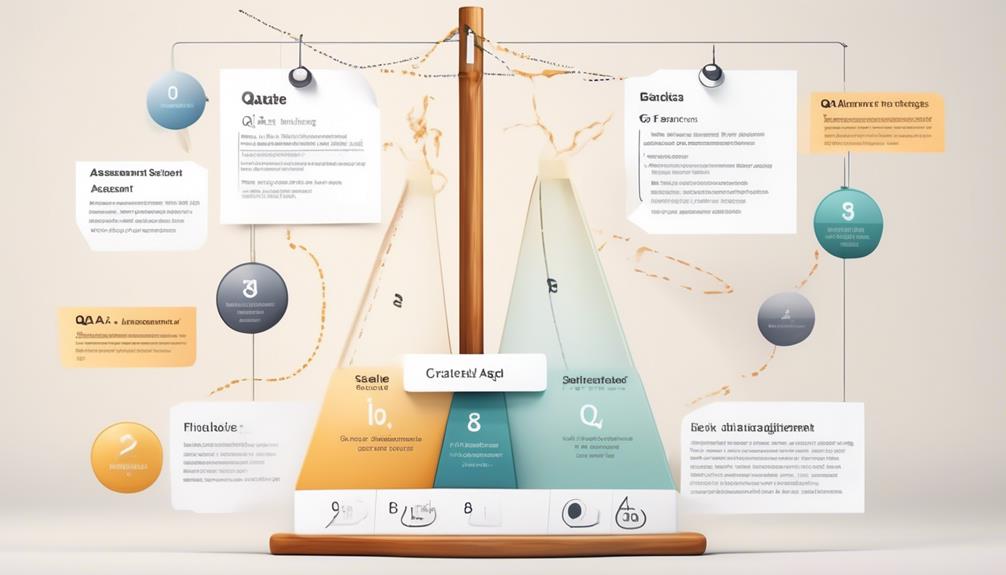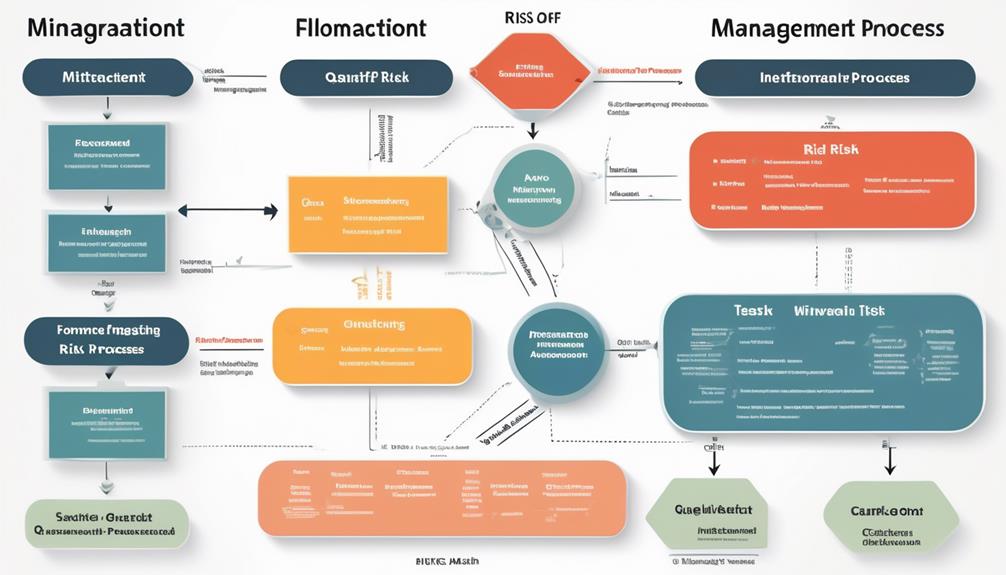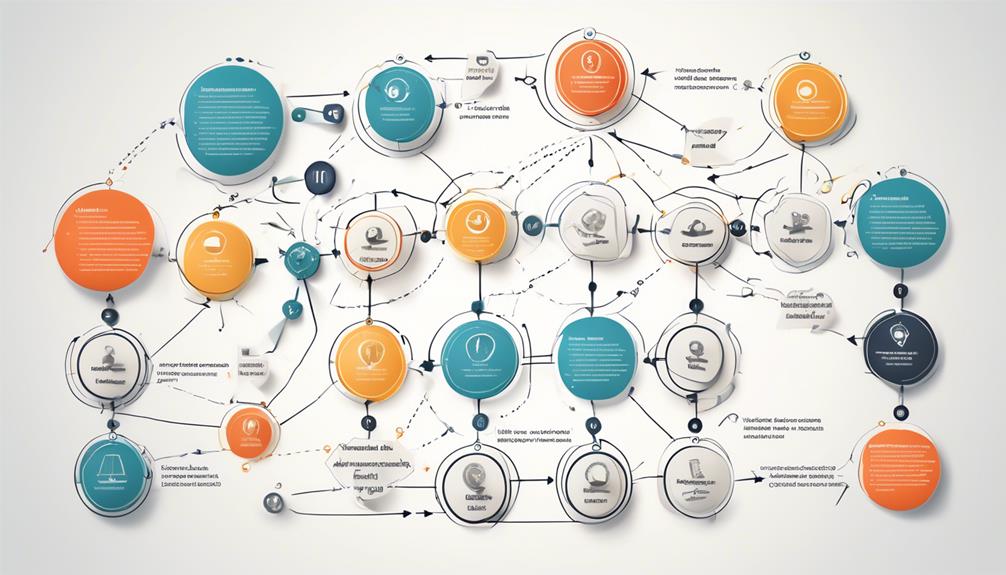Have you ever encountered moments when everything appears to be going smoothly, only for unforeseen chaos to abruptly emerge? That is why it is essential to have risk mitigation strategies in place for quality assurance.
It's not just about preventing potential disasters; it's about safeguarding the quality and success of software development.
Trust me, you'll want to stick around to learn how risk mitigation in QA can be the game-changer your team needs to navigate the unpredictable terrain of software testing and development.
Key Takeaways
- Risk mitigation is essential in QA as it involves the proactive identification and management of potential issues and vulnerabilities in the software development process.
- QA professionals play a pivotal role in continuously assessing and addressing potential risks to ensure the reliability and performance of software.
- Risk identification and mitigation strategies involve defining risk criteria, identifying risk sources, assessing risk impacts, and implementing preventive measures.
- The involvement of stakeholders in risk mitigation leads to a more thorough and robust approach to risk management, as they actively contribute to the identification and assessment of potential risks and ensure effective implementation of risk mitigation measures.
Defining Risk Mitigation in QA
In Quality Assurance, risk mitigation refers to the proactive identification and management of potential issues and vulnerabilities in the software development process to ensure the delivery of a high-quality product.
Risk management is integral to the Quality Assurance (QA) process, as it involves the systematic approach of identifying, analyzing, and responding to project risks.
In the context of software testing, risk mitigation in QA aims to minimize the impact of potential threats to the quality and success of the software. This involves a comprehensive understanding of the project's objectives, requirements, and potential areas of vulnerability.
Quality Assurance professionals play a pivotal role in risk mitigation by continuously assessing and addressing potential risks throughout the software development lifecycle. This proactive approach allows for the implementation of effective strategies to minimize the impact of potential risks and ensure the delivery of a high-quality, reliable software product.
Importance of Risk Mitigation in QA

As QA professionals, we understand the critical importance of risk identification in ensuring the reliability and performance of software.
Mitigating testing challenges is essential for maintaining the integrity of the QA process and the quality of the final product.
Risk Identification in QA
Accurately identifying and managing risks in testing is a crucial component of maintaining software quality, requiring proactive risk assessment and the implementation of preventive measures in QA. Heightened risk awareness is essential for quality risk management in QA to prevent software failures.
The following key components are vital for effective risk identification and mitigation in QA:
- Defining risk criteria
- Identifying risk sources
- Assessing risk impacts
- Selecting risk responses
Mitigating Testing Challenges
Mitigating Testing Challenges in QA necessitates a proactive approach to minimize the impact of potential risks on software quality, building upon the foundational risk identification practices. To effectively mitigate the risk, it is essential to understand the challenges faced during the testing process. The table below outlines key testing challenges and corresponding risk mitigation strategies:
| Testing Challenges | Risk Mitigation Strategies | Importance |
|---|---|---|
| Resource constraints | Prioritize testing efforts and automate repetitive tasks | Ensures efficient use of resources |
| Time limitations | Implement risk-based testing and prioritize critical functionalities | Maximizes testing effectiveness within constraints |
| Changing requirements | Maintain clear communication and documentation, conduct impact analysis | Ensures alignment with evolving requirements |
| Complex system integrations | Perform thorough integration testing and utilize simulation tools | Minimizes integration-related risks |
Implementing these strategies enhances risk management in QA, ensuring a proactive and effective approach to mitigate potential challenges in the testing process.
Ensuring Software Reliability
To ensure software reliability, proactive risk mitigation in QA is essential for minimizing potential challenges and optimizing product quality and reliability. Implementing effective risk mitigation strategies is crucial in the software development lifecycle to enhance the overall QA process.
This includes:
- Proactively identifying and assessing potential risks in software development.
- Implementing measures to mitigate identified risks early in the QA process.
- Involving testers in risk identification and management to ensure comprehensive coverage.
- Continuously monitoring and reassessing risks throughout the development cycle to adapt to changing circumstances.
Key Elements of Risk Mitigation

As we examine the key elements of risk mitigation in QA, it's crucial to focus on identifying potential risks and implementing preventive measures.
By proactively identifying potential risks, we can develop targeted strategies to mitigate them before they escalate.
Implementing preventive measures is essential in minimizing the impact of potential risks on the quality assurance process.
Identifying Potential Risks
After conducting a thorough analysis of our testing processes, we proactively identify potential risks by closely examining the various stages of our quality assurance procedures. This is a critical step in our risk management process as it allows us to anticipate and address potential issues before they impact the overall quality of our product.
In identifying potential risks, QA teams need to consider factors such as the complexity of the software, dependencies on external systems, potential security vulnerabilities, and the impact of changes in requirements. By systematically evaluating these aspects, we can better understand where vulnerabilities lie and take proactive measures to mitigate them, ultimately ensuring a higher level of quality in our deliverables.
Implementing Preventive Measures
In order to proactively address potential risks, we establish specific criteria, including probability, severity, urgency, and tolerance, to evaluate and prioritize risks effectively. Implementing preventive measures involves a comprehensive approach to risk management. The table below outlines key elements of risk mitigation.
| Key Elements | Description |
|---|---|
| Defining Risk Criteria | Establish criteria such as probability, severity, urgency, and tolerance. |
| Identifying Risk Sources | Identify internal and external sources of risks, including technical and human factors. |
| Assessing Risk Impacts | Evaluate the positive or negative effects of risks on performance, quality, and value. |
| Selecting Risk Responses | Implement proactive or reactive actions to reduce, transfer, avoid, or accept risks. |
Understanding Risk Assessment in QA

How can we accurately assess and manage risks in testing to ensure software quality in QA?
Risk assessment in QA is critical for identifying potential issues that could impact the software's quality. To understand risk assessment in QA, we must consider the following:
- Identifying Potential Risks: It's essential to comprehensively identify all potential risks that could impact the quality of the software being tested.
- Assessing Likelihood and Impact: Evaluating the likelihood of a risk occurring and its potential impact on the software is crucial for effective risk assessment.
- Defining Risk Criteria: Establishing clear criteria for categorizing and prioritizing risks based on their potential impact and likelihood of occurrence is fundamental.
- Implementing Mitigation Strategies: Developing and implementing mitigation strategies to address identified risks is essential for reducing their potential impact on the software.
Understanding risk assessment in QA involves a meticulous and proactive approach to identifying, evaluating, and managing potential risks that could impact the quality of the software being tested. By effectively managing risks, QA teams can ensure the delivery of high-quality software products.
Implementing Effective Risk Strategies

With a thorough understanding of risk assessment in QA, we are now ready to address the implementation of effective risk strategies to safeguard software quality. Risk management is a critical aspect of ensuring the overall quality of software products. By implementing effective risk strategies, we can proactively identify, assess, and mitigate potential issues that may impact the quality and reliability of the software. Below is a table outlining key risk management strategies and their impact on quality and testing efforts:
| Risk Strategy | Impact on Quality | Impact on Testing Efforts |
|---|---|---|
| Early Risk Identification | Minimizes the likelihood of major quality issues | Allows for focused testing on high-risk areas |
| Risk prioritization | Ensures that critical quality aspects are addressed | Helps in allocating testing resources wisely |
| Continuous monitoring | Enables proactive quality maintenance | Facilitates adaptive testing strategies |
Implementing these risk strategies allows for a proactive approach to quality assurance, leading to higher quality software products, optimized testing efforts, and improved customer satisfaction.
Role of Stakeholders in Risk Mitigation

Stakeholders actively contribute to the identification and assessment of potential risks in software development and testing, providing valuable insights and perspectives for comprehensive risk management. Their involvement plays a vital role in the effective implementation of risk mitigation measures and the continuous improvement of the risk management process. In the context of QA testing, stakeholders ensure that risks aren't overlooked, leading to better project success and customer satisfaction.
When it comes to risk mitigation in QA, the role of stakeholders is essential for ensuring the quality and reliability of the software being developed. Here are the key ways in which stakeholders contribute to risk mitigation:
- Identification and assessment of potential risks
- Providing valuable insights and perspectives
- Prioritizing risks based on criticalness, regulatory requirements, customer impact, and business objectives
- Ensuring effective implementation of risk mitigation measures
Stakeholders' active involvement in risk management in QA testing leads to a more thorough and robust approach to identifying, assessing, and mitigating risks, ultimately enhancing the quality and success of software development projects.
Integrating Risk Management in QA Processes

As we explore the integration of risk management in QA processes, we'll delve into the crucial aspects of risk identification, mitigation strategies, and impact assessment.
Our focus will be on developing a comprehensive understanding of how to identify potential risks, formulate effective strategies to mitigate them, and assess the impact of these risks on QA processes.
Risk Identification
To integrate risk management into QA processes, we start by defining risk criteria to prioritize potential risks that require immediate attention.
Risk identification involves a thorough assessment of risk sources, including internal and external factors impacting requirements, design, testing, or deployment.
We also evaluate the likelihood of these risks occurring by using historical data and expert opinions to define risk criteria.
Additionally, we assess the potential impacts of these risks, measuring the benefits or losses and determining quality and risk trade-offs.
Finally, we select appropriate risk responses, taking proactive or reactive actions to reduce, transfer, avoid, or accept risks.
Mitigation Strategies
Mitigation strategies play a crucial role in integrating risk management into QA processes by proactively addressing and minimizing potential risks. In the realm of risk mitigation, QA teams employ various strategies to anticipate, prevent, and lessen the impact of potential issues. These strategies encompass a wide array of approaches, including risk avoidance, risk transfer, risk reduction, and risk acceptance.
By identifying potential risks early on and implementing targeted mitigation strategies, QA teams can significantly enhance the quality and reliability of the final product. Moreover, integrating risk mitigation into QA processes fosters a proactive and forward-thinking mindset within the team, leading to a more robust and resilient QA framework.
Through the systematic application of mitigation strategies, QA professionals can effectively safeguard against potential disruptions and ensure the overall success of the project.
Impact Assessment
Impact assessment in the realm of risk management within QA processes involves evaluating the potential damage caused by identified risks and is crucial for prioritizing immediate attention and resources.
- It aids in measuring the consequences of risks on performance, quality, and value.
- Integrating impact assessment into risk management ensures proactive identification and mitigation of risks.
- Effective impact assessment contributes to better decision-making and resource allocation in QA processes.
- It's essential for prioritizing risks that require immediate attention and resources in the QA process.
Implementing impact assessment in the quality assurance process allows for a thorough understanding of the potential impacts of identified risks, enabling proactive measures to mitigate these risks and ensure the delivery of high-quality products or services.
Best Practices for Risk Mitigation

As we focus on best practices for risk mitigation in QA, it is essential to integrate stakeholder involvement, regularly update risks, and continuously improve the process. In the table below, we outline key best practices for effective risk mitigation in QA.
| Best Practices for Risk Mitigation | Description |
|---|---|
| Stakeholder Involvement | Engage stakeholders to gather diverse perspectives, define risk criteria, and prioritize mitigation efforts. |
| Regular Risk Updates | Continuously monitor and update risk registers to reflect the evolving nature of risks and ensure timely responses. |
| Integration into Testing Process | Embed risk management activities into the testing process to proactively identify and address potential issues. |
| Continuous Process Improvement | Implement a feedback loop to analyze the effectiveness of risk mitigation strategies and refine processes. |
| Heightened Risk Awareness | Foster a culture of heightened risk awareness to empower teams to identify, assess, and mitigate risks effectively. |
Adhering to these best practices can significantly enhance the overall risk management process in QA, ultimately leading to improved product quality and customer satisfaction. By integrating stakeholder involvement, regular risk updates, and continuous process improvement, organizations can better anticipate and mitigate the impact of risks on QA processes.
Common Risks in QA Processes

Given the emphasis on best practices for risk mitigation in QA, our attention now turns to examining the common risks encountered in QA processes. It's crucial to identify potential risks in order to proactively minimize their impact.
The following are common risks in QA processes:
- Ambiguous Requirements: Unclear or changing requirements can lead to inadequate testing and result in a product that doesn't meet customer expectations.
- Outdated Tools: Using outdated testing tools and technologies can lead to inefficiencies, inaccurate results, and an inability to keep up with industry standards.
- Insufficient Resources: Limited time, budget, or manpower can hinder the thoroughness and effectiveness of the QA process, leading to overlooked issues and potential failures.
- Unforeseen Scenarios: Failure to account for unexpected scenarios such as high traffic loads, security breaches, or system failures can result in significant risks going unnoticed until it's too late.
Understanding and addressing these common risks is essential for effective risk management in QA processes. By doing so, it becomes possible to minimize the impact of these risks and ensure the successful delivery of high-quality products.
Continuous Monitoring and Review

Continuous monitoring and review play a pivotal role in maintaining the effectiveness and adaptability of risk management strategies within the QA process. It involves regularly tracking and evaluating risks to ensure that they are not only identified but also constantly assessed for any changes or new developments. This continuous improvement approach allows for adjustments to risk management strategies as necessary, ensuring proactive risk mitigation. Through ongoing vigilance, new risks that may emerge during the QA process can be detected and addressed promptly. Continuous monitoring and review are essential for maintaining an effective and adaptive risk management approach in QA.
| Benefits of Continuous Monitoring and Review |
|---|
| Regularly tracks and evaluates risks |
| Ensures proactive risk mitigation |
| Allows for adjustments to risk management strategies |
| Detects and addresses new risks promptly |
This proactive approach to monitoring risks not only enhances the overall quality of the QA process but also provides a solid foundation for identifying and addressing potential issues before they escalate. By consistently reviewing and adapting risk management strategies, QA teams can effectively navigate challenges and maintain the integrity of their processes.
Documentation and Communication in Risk Mitigation

We meticulously document identified risks, assessments, and mitigation strategies to ensure a comprehensive and consistent approach to managing risks in QA. This documentation serves as a crucial reference for our team, providing a clear understanding of potential risks and the strategies in place to address them.
In addition to documentation, effective communication is essential for successful risk management. By clearly communicating responsibilities and progress to our QA team members and stakeholders, we facilitate the implementation and monitoring of risk mitigation measures.
Maintaining a central repository for risk-related information and updates promotes accessibility and transparency within our team, ensuring that everyone is on the same page regarding risk management.
Furthermore, regularly updating risk lists and integrating risk management into the testing process helps us avoid overlooking or inadequately addressing potential risks.
Learning and Improving Through Risk Mitigation

Utilizing a proactive approach to risk mitigation allows us to continuously learn and improve our testing processes, elevating our ability to anticipate and address potential challenges.
By integrating risk management into our QA practices, we can systematically identify, assess, and prioritize risks, leading to continuous improvement in our testing strategies.
Through regular risk assessments, we gain insights into potential vulnerabilities and areas that require enhancement, enabling us to adapt and refine our testing methodologies.
This iterative process of risk mitigation fosters a culture of continuous improvement, where we actively learn from past experiences and use that knowledge to enhance future testing endeavors.
As we prioritize risk mitigation goals such as planning for disasters and lessening negative impacts, we not only mitigate current risks but also gather valuable insights for future projects.
Embracing a proactive approach to risk management empowers us to evolve and strengthen our testing processes, ultimately enhancing our ability to deliver high-quality software products.
Frequently Asked Questions
Why Is Risk Mitigation Important?
Mitigating risks is vital for ensuring software quality and project success. By identifying and addressing potential threats, we minimize negative impacts and prioritize testing efforts effectively.
Proactive risk management prevents software failures, safeguards a company's reputation, and enhances customer satisfaction. Assessing, prioritizing, and implementing risk mitigation strategies in QA processes leads to improved product quality and overall project success, making it crucial for our team's success.
How Do You Mitigate Risk in Qa?
Mitigating risk in QA is vital for ensuring product quality. We identify potential issues early, prioritize them based on impact, and develop strategies to address them.
By implementing rigorous testing and proactive monitoring, we minimize the likelihood of defects reaching the customer. This approach fosters confidence in our product and instills trust with our stakeholders.
It also saves time and resources in the long run, ensuring a smoother development process.
Why Is Risk Management Important in Testing?
Risk management is vital in testing as it ensures the software's quality and reliability. By assessing likelihood and potential damage, we can effectively mitigate negative consequences.
Identifying and managing risks is crucial for successful testing. It's a determining factor in our job, emphasizing its importance. We make risk assessments, evaluate potential events, and assess the acceptability of risk.
This proactive approach is essential for ensuring high-quality software.
What Is the Purpose of the Risk Management and Quality Assurance Program?
The purpose of the Risk Management and Quality Assurance program is to:
- Identify, assess, and prioritize potential risks in software development and testing.
- Minimize the impact of risks on product quality, reliability, and security.
- Optimize resource allocation and testing efforts.
This involves:
- Incorporating risk management into the testing process.
- Regularly updating risks.
- Involving stakeholders.
- Continuously improving the risk management process.
Conclusion
Just as a ship captain navigates through stormy seas by identifying and avoiding potential hazards, QA teams must steer their software development projects through potential risks with proactive risk mitigation strategies.
By continuously monitoring and updating their risk management processes, QA teams can ensure the smooth sailing of their projects, minimizing the negative impact of risks on software quality.
Ultimately, this leads to the success of their endeavors.
Rick, our Software Quality Assurance Writer, is the creative force behind many of our insightful articles and course materials. His unique background in software development, fused with his natural flair for writing, allows him to convey complex QA concepts in a way that is both informative and captivating. Rick is committed to keeping abreast of the latest trends and advancements in software testing, ensuring that our content remains not just relevant, but at the forefront of the field. His significant contributions are instrumental in helping us fulfill our mission to deliver premier QA education.










